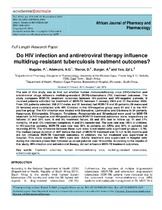| dc.contributor.author | Mugabo, Pierre | |
| dc.contributor.author | Adewumi, A.O. | |
| dc.contributor.author | Theron, Danie | |
| dc.contributor.author | Burger, Andries | |
| dc.contributor.author | Van, Zyl L. | |
| dc.date.accessioned | 2016-06-08T12:17:00Z | |
| dc.date.available | 2016-06-08T12:17:00Z | |
| dc.date.issued | 2015 | |
| dc.identifier.citation | Mugabo, P. et al. (2015). Do HIV infection and antiretroviral therapy influence multidrug-resistant tuberculosis treatment outcomes? African Journal of Pharmacy and
Pharmacology, 9(35): 875-880 | en_US |
| dc.identifier.issn | 1991-637X | |
| dc.identifier.uri | http://hdl.handle.net/10566/2297 | |
| dc.description.abstract | The aim of this study was to find out whether human immunodeficiency virus (HIV)-infection and antiretroviral drugs influence multidrug-resistant (MDR)-tuberculosis (TB) treatment outcomes. The study compares MDR-TB treatment outcomes between HIV-positive and HIV-negative patients. It involved patients admitted for treatment of MDR-TB between 1 January 2004 and 31 December 2006. From 363 patients selected, 268 (177 males and 91 females) had MDR-TB and 95 patients (59 males and 36 females) were co-infected with HIV. Children in the HIV-negative group were 41 and 7 in the HIV-positive group. The HIV-infection was treated with Stavudine, Lamivudine and Efavirenz in 54 patients. Kanamycin, Ethionamide, Ofloxacin, Terizidone, Pyrazinamide and Ethambutol were used for MDR-TB treatment. In HIV-negative and HIV-positive patients MDR-TB treatment outcomes were, respectively as follows: 37 and 35% cure, 9 and 5% treatment failure, 20 and 25% lost to follow up, 11 and 17% mortality, 19 and 13% treatment completed, 6 and 5% transfer-out. The cure rate was 100% in children. In HIV-positive patients, MDR-TB cure rate was 35% in patients on ARVs and 34% in patients not receiving ARVs. The difference between these cure rates is not statistically significant (p-value = 0.79). The median (range) duration of ART before the start of MDR-TB treatment was 10.5 (1 to 60) months and did not influence MDR-TB treatment outcomes. In children, the full treatment was supervised in hospital. This could explain the 100% cure rate. Adults' treatment was supervised in hospital only during the intensive phase then followed up as out patients over 18 months. According to the results of this study, HIV-infection and antiretroviral therapy did not influence MDR-TB treatment outcomes. | en_US |
| dc.language.iso | en | en_US |
| dc.publisher | Academic Journals | en_US |
| dc.rights.uri | Academic Journals strongly supports the Open Access initiative. Abstracts and full texts of all articles published by Academic Journals are freely accessible to everyone immediately after publication. | |
| dc.source.uri | http://dx.doi.org/10.5897/AJPP2015.4298 | |
| dc.subject | HIV infection | en_US |
| dc.subject | Multi-drug resistant tuberculosis (MDR-TB) | en_US |
| dc.subject | Antiretroviral agents | en_US |
| dc.subject | Treatment | en_US |
| dc.title | Do HIV infection and antiretroviral therapy influence multidrug-resistant tuberculosis treatment outcomes? | en_US |
| dc.type | Article | en_US |
| dc.privacy.showsubmitter | FALSE | |
| dc.status.ispeerreviewed | TRUE | |

